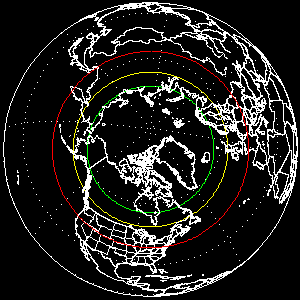
W H A T I S K P I N D E X ?

The Kp index is an indicator of electric currents flowing in the ionosphere
that may be associated with visible Aurora. It is actually determined by
measuring abnormal deflections in the Earth's magnetic field at the surface
caused by these electrical currents, using a ring of magnetic observatories at
varying latitudes throughout the world.
The Kp index tells us at what magnetic latitude we should expect to see an
Aurora. Magnetic latitude is different from geographic latitude in that it uses
the orientation of the Earth's magnetic pole as a reference, instead of the
Earth's rotational axis, as 90 degrees latitude. Since the magnetic pole is
offset from the rotational axis by over 22 degrees, there is a difference
between magnetic latitude and geographic latitude. Auroral currents only care
about the Earth's magnetic field - and thus geographic coordinates are
irrelevant! Hence the Kp index tells us at what magnetic latitude to expect
Aurora.
You can use the form on the Kp page to determine your magnetic latitude based
on your geographic latitude and longitude. As a guide, the table below
summarizes what different values of the Kp index mean in terms of auroral
visibility at different magnetic latitudes:
Magnetic latitude |
|
As you can see, as the value of the Kp index increases, the magnetic latitude for auroral viewing decreases. This is a result of widening auroral ovals about the geomagnetic poles, and is one indicator of the amount of solar wind energy penetrating the Earth's ionosphere.
Kp is monitored and forecasted by the Space Environment Center (SEC) run by NOAA, using data from a network of magnetometers in the northern hemisphere.
CURRENT CONDITIONS
[CME]
[Solar Wind]
[Storms]
[Auroral Kp]
[Particles]
TUTORIALS
[Forecasting Space Weather]
[Aurora: Dawn of the North]